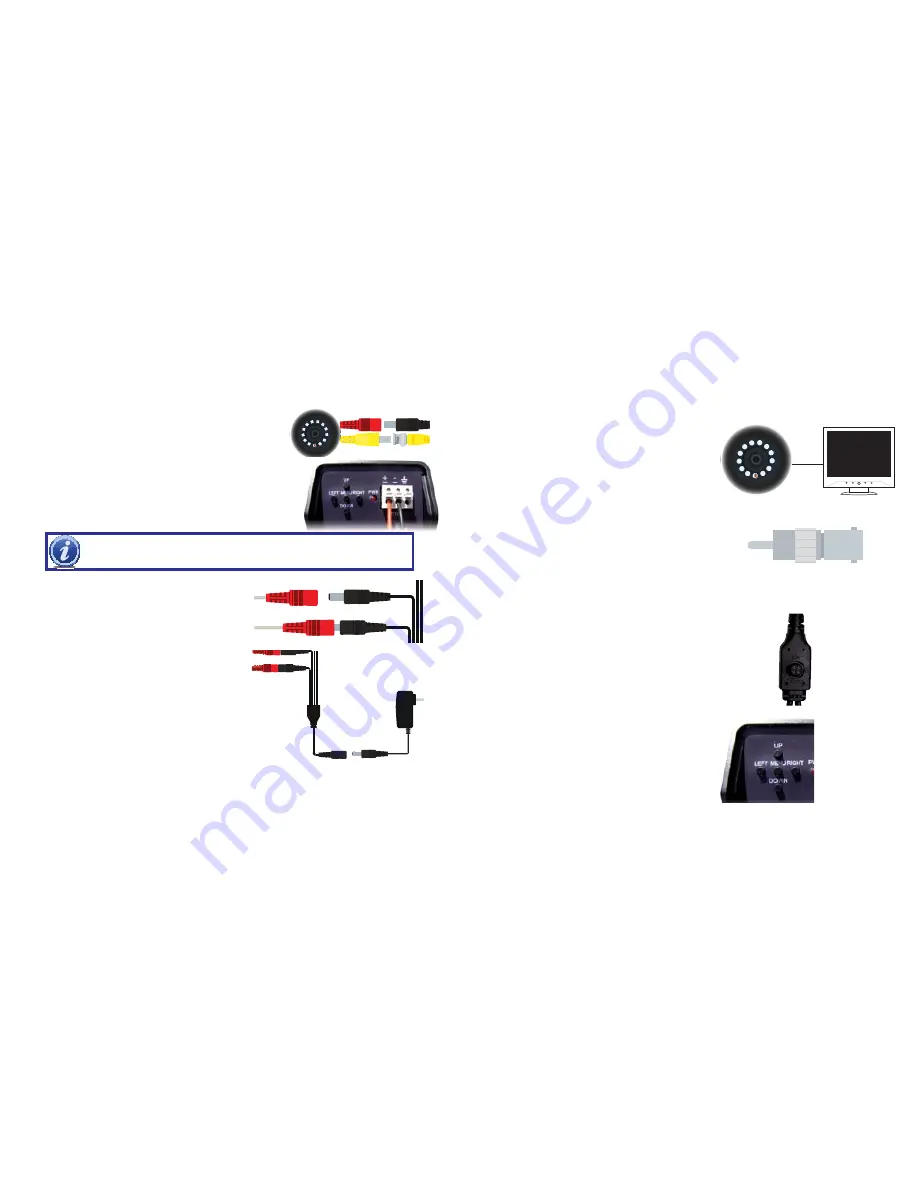
8
9
CONNECTING THE CAMERA TO A SE-
CURITY DVR SYSTEM
CAMERA
STEP 2.
For multi-camera packs
, connect the power lead on the
other end of the cable to the plug from the power splitter. Or, if
your package includes a power distribution panel, connect the
power lead to one of the power jacks on the panel. Proceed to
Step 4
, below.
For single camera packages
, connect the power lead to the
power adapter itself. In this case, you may skip to
Step 4
.
STEP 3
. Connect the power lead on the power splitter to the
camera power adapter.
DO NOT
plug the adapter into an
outlet at this time.
STEP 4
. Connect the BNC connector on the other end of the video/
power cable to a
Video In
port on the back of the DVR.
STEP 1.
Connect the BNC and power leads from the camera to the
matching connectors on one end of the power and video cable.
Some box cameras require a special adapter with bare wire leads.
The ends of the wires must be inserted into the Positive (+) and
Negative (-) ports on the power input box at the back of the camera.
The power cable plug connects to the attached female power jack on
this adapter.
IMPORTANT!
When connecting the power and video cable between the camera and the DVR, the
“male” power end (red plug in the illlustration) connects to the matching power lead on the camera.
Repeat Steps 1 through 4 for all cameras before continuing.
STEP 5
. Plug the power adapter into a surge protector* or
turn on the power panel.
*When selecting a surge protector, it is STRONGLY recommended to use one that is UL-1449 rated, for a clamping voltage
of 330 or lower, a Joule rating of at least 400 and a response time of 10 nanoseconds or less.
CAMERA
TV or MONITOR
STEP 1.
Connect the camera to the cable and power supply as
described in Steps 1, 2 and 5 above before connecting it to
your video display.
STEP 2.
Connect the camera to the “Video In” port on the
monitor or television.
CONTROLLING YOUR CAMERA
The camera’s on-screen menu is accessed by the multifunction button attached to the camera cable. On certain models of box
cameras, a group of five buttons makes up the multi-function controls. The operation of both types of control is similar.
To access the on screen display, press the control or menu button.
This will bring up the menu on your system’s monitor or other attached
display. This button also acts as the “
Enter
” button when setting your
parameters.
Navigate through the menu using the directional controls. The cable-
mounted multi-function button acts as a miniature joystick allowing you
to move up, down, left or right through the menu and submenus. On
the some box cameras, the individual directional buttons on the camera
itself will move you through the on screen display.
In addition to the on-screen settings, you can adjust the camera’s
zoom, focus, and in some cases the light level (iris). These adjustments
can generally be made externally with the exception of some dome
cameras which will require removal of the cover to adjust.
Cable-Mounted
Multi-Function
Button
Box Camera
Multi-Function
Controls
CONNECTING THE CAMERA TO A TV OR MONITOR
A single camera can be connected directly to a monitor or TV with an RCA input using the included cable and a separately available
adapter if needed.
For Television: You may need to tune or select the correct INPUT (i.e.; A/V, L1, L2, Source) Consult your television’s manual for details.
Depending on your TV or monitor, you may need to use a BNC-to-
RCA adapter (not included) to connect the BNC connector on the
video/power cable to your screen.











